The End of Human Civlisation: War, Empire and Racism in the Anthropocene
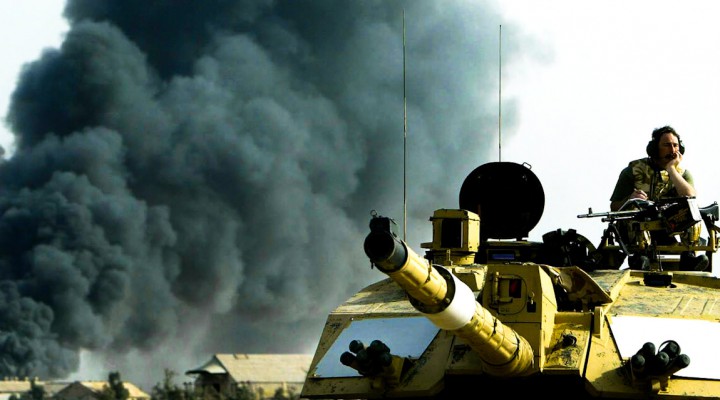
For the first time in history, the future of the entire planet — for generations if not millennia to come — is now being fundamentally determined by the activities of the human species.
by Nafeez Ahmed
INSURGE INTELLIGENCE — The Anthropocene. A proposed new geological epoch which designates a shift to a planetary age dominated by human impacts across the geological processes of the Earth. Geologists dispute the duration, precision, relevance and even accuracy of the concept. But the term has increasingly entered the scientific lexicon as increasing numbers of experts across myriad disciplines recognise that for the first time in history, the future of the entire planet — for generations if not millennia to come — is now being fundamentally determined by the activities of the human species. But the Anthropocene is about far more than just climate change. It is about an entire system of life, whose design is to maximise resource extraction at the expense of expendable ‘Others’. It is bound up, intimately, with a global system of racism emerging from the legacy of centuries of colonialism. And it is inseparable from the ceaseless sequence of industrial wars, culminating in today’s permanent state of the endless ‘war on terror’.
Terraforming the Earth beyond recognition
It is the unprecedented impact of anthropogenic climate change that has, perhaps, played the biggest role in efforts to define the Anthropocene as a distinctive new era in Earth’s history. Multiple warnings backed by a global consensus of climate scientists have warned over the last few decades that human activities, through the escalating consumption of fossil fuel resources — the burning of oil, gas and coal — is destabilising the Earth’s natural carbon cycle.
For hundreds of thousands of years, the planet has sustained an equilibrium, a ‘safe operating’ space offering an optimum environment for human and other habitation — in which the quantity of carbon emitted and absorbed by planetary ecosystems remains stable.
But since the Industrial Revolution, as human civilisation has inexorably expanded, consuming greater quantities of fossil fuel energy along the way, associated carbon dioxide (CO2) emissions have exponentially increased — overwhelming the planet’s capacity for absorption. The result has been a steady increase in global average temperatures.
Scientists warn that the extra addition of CO2 into the atmosphere, capturing greater heat, is in turn playing escalating havoc with the Earth’s climate, weather and ecological systems. As human civilisation continues its expansion, as it continues to burn up escalating quantities of fossil fuels, the climate science community warns that above a certain level of CO2 and global heating, planetary ecosystems will shift passed a key tipping point into a new, dangerous era — one that is outside the boundaries of the preceding hundreds of thousands of years, outside anything human beings have ever experienced.
If we continue on this pathway of business-as-usual, conservative projections suggest we are heading toward anywhere between a 3 to 6 degrees Celsius global average temperature rise.
Others, such as Schroders, the global investment firm, have suggested we could be heading toward an 8C planet due to the current rate of fossil fuel consumption — the 8C temperature projection was also suggested by a study funded by US Department of Energy’s Climate Change Research Division, which highlighted the potential impact of ‘amplifying feedback loops’ triggered by altering earth system processes that might trigger further greenhouse gas loading.
Between 4–6C, most climate scientists agree that there would be such a degree of chaos that the planet would become largely uninhabitable. The variation is complicated, and depends on a concept called ‘Earth System Sensitivity’ — how sensitive the planet’s ecosystems are to the CO2 change. But even at a conservative estimate of sensitivity, a 3C planet, to which at minimum we are likely heading, should be considered “extremely dangerous”; and a global average temperature rise within the 3–4C threshold would probably create conditions that make the core infrastructures of human civilisation increasingly unviable.
To the extent that governments are taking seriously this threat, they are doing so largely with a view to assess the implications for their own functioning — and with a view to consider how to sustain business-as-usual amidst rising instability. This is the context in which many studies have concluded that our current climate change trajectory will increase the chance of conflict. For the most part, Western national security agencies that have examined the issue agree that while climate change does not automatically produce war, it acts as an ‘amplifier’ which increases the prospect of war, due to its impacts in terms of water scarcity, the degeneration of critical food systems, the failure of conventional energy supplies, and the unpredictable impact of extreme weather events. Such impacts can sometimes devastate infrastructures and lead to the collapse of public services. In those contexts, the proliferating outbreak of wars and conflicts is widely recognised to be a likely symptom of climate change on a business-as-usual pathway.
The problem is that this usually leads to little reflection on the need to change the human system that is producing this trajectory — instead, we are largely told of the need for a greater expansion of security powers to respond to the chaos of a climate-impacted world: the intensification of the same system that produced the problem.
On the polar opposite of the spectrum, we have outright state denialism rooted in the goal of protecting the system of endless fossil fuel exploitation at any conceivable cost. It is telling that the Trump administration, as of March 2019, was considering the creation of a White House panel to dispute the findings of dozens of US military and intelligence assessments on the grave security risks posed by climate change. Which is interesting, given that the Pentagon emits more fossil fuel emissions than as many as 140 different countries.

Sailors conduct flight operations on the USS Carl near North Korea. Photo | U.S. Navy
And yet, the preoccupation with war that emerges from the narrow lens of ‘national security’ through which the human gaze is obsessed primarily with physical threats to the interests of nation-states, is ultimately counterproductive, symptomatic of the fragmentary cognitive framing in which human institutions are currently capable of thinking and acting — it focuses myopically on how to uphold the survival of the business-as-usual operations of the state and the interests lobbying through it, overlooking the global existential character of the crisis as a threat to the whole species.
At the worst end of the scale, war would be the least of our problems: we have the risk of a ‘hothouse’ Earth. A study in the Proceedings of the National Academy of Sciences found that the risk of an uninhabitable planet is not simply a far off possibility that might be triggered at several degrees of temperature rise in a more distant future — it could be triggered imminently; and it is possible that it may already have been triggered at the current level of an approximate 1C temperature rise above the pre-industrial average, which NASA’s former chief climate scientist James Hansen had argued is the safe upper limit, beyond which we move into a dangerous and more unpredictable climate with some consequences that may be irreversible.
But climate change is only one facet of the crisis. Our civilisational model, which has exponentially increasing energy and resource consumption as its driving motor, has seen human activities, exploitation and waste-generation accelerate across the planet. This has driven an escalating biodiversity crisis leading to potentially irreversible changes to soils and oceans, underpinning mass species extinctions.
Human civilisation and the war on life
About 15 years ago, the UN’s Millennium Ecosystem Assessment provided one of the first and most damning insights into the destruction wrought by humans that defines the Anthropocene. The report pinpointed the mid-twentieth century as a marked tipping point into a new era, where rapidly intensifying industrial agriculture accompanied an escalating collapse of biodiversity.
Consumption of food, water and fuel has not only exponentially increased, it has exponentially encroached on habitats — more in the preceding 50 years alone than throughout all of human history. The extinction rate of species was “up to one thousand times higher than the fossil record”, when “every thousand mammal species, less than one went extinct every millennium”. The UN assessment projected that the rate is still going up, and will be “ten times higher” in the near future.
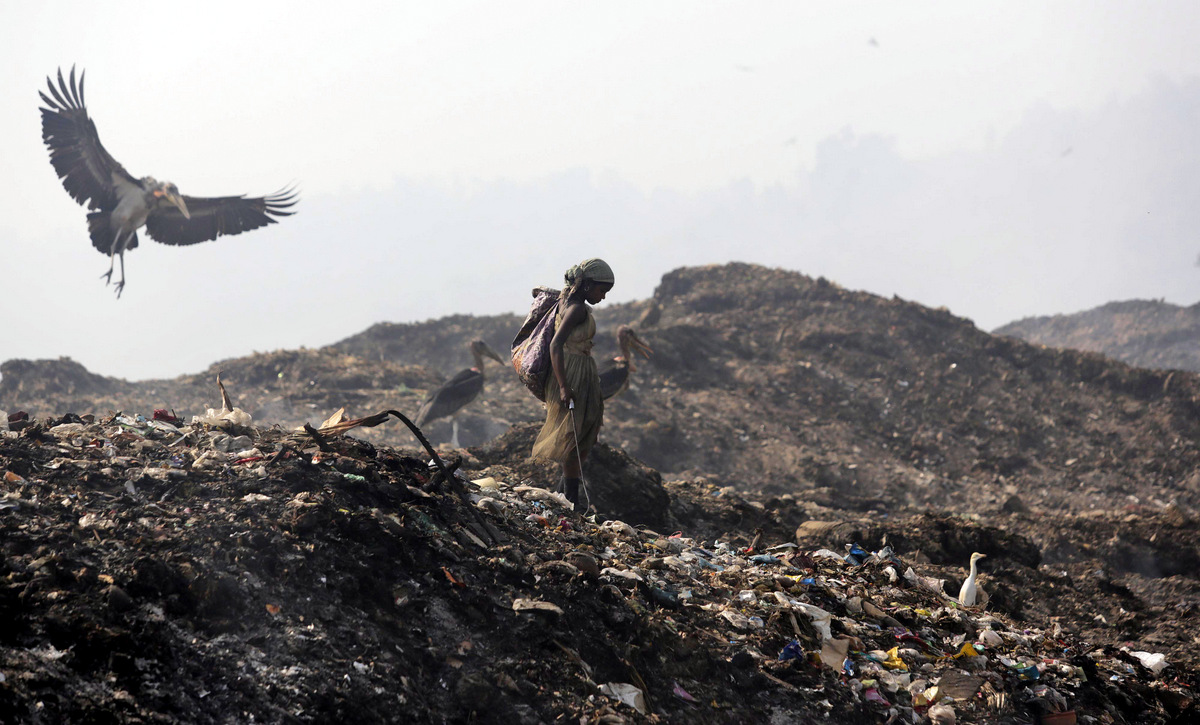
A girl searches recyclable materials near endangered Greater Adjutant Storks at a dumping site on the outskirts of Gauhati, India. Anupam Nath | AP
The situation is now far worse than expected. This year, the UN’s Intergovernmental Science-Policy Platform on Biodiversity and Ecosystem Services concluded that one million of the planet’s 8 million animal and plant species are at risk of going extinct in the near future, due to the expansion of human societies that has driven climate change, the loss of habitat, overfishing, pollution and invasive species.
Numerous studies have warned that our present trajectory is heading toward the collapse of our current form of civilisation. One model developed with NASA funding indicated that the current endless growth model of human civilisation was likely to lead to diminishing returns and deepening economic stratification, eventually culminating in collapse. All civilisations, the model seemed to show, tend to follow a growth trajectory consisting of an increasing intensification in complexity, whereby greater layers of complexity are continuously innovated to solve problems.
With each new layer, more complex problems are generated, requiring a further even more complex layer of problem-solving to address them, which in turn generates further problems. The cycle, drawing on the work of archaeologist Joseph Tainter who studied dozens of past civilisations, suggests that any civilisation will eventually collapse under the unsustainable weight of its own complexity due to excessive resource consumption and internal maldistribution of wealth — unless consumption and distribution begin to be rectified in time.
This particular model was fairly simple, focusing on a smaller number of variables to explore the general plausibility of the core hypothesis. A few years later, a far more complex scientific model with thousands of data inputs was developed by Anglia Ruskin University’s Global Sustainability Institute. with funding from the British Foreign Office. When run forward on a business-as-usual trajectory, the model suggested that human civilisation would probably collapse around 2040 amidst an eruption of converging climate, energy, food and water crises that would devastate major economies amidst an epidemic of food riots. Conventional war might happen — but either way, the planet would likely experience a proliferation of civil unrest within, between and across borders.
This year, a scenario analysis backed by the former head of Australia’s military drew on the peer-reviewed scientific literature to outline a plausible business-as-usual trajectory, based on what we know about how planetary ecosystems can respond to human-induced CO2 emissions. The scenario took seriously the scientific evidence of a potential ‘hothouse’ Earth scenario. It suggested that by 2050, human societies would face “outright chaos” due to escalating climate-impacts on key ecosystems, with two billion people suffering from water scarcity and another billion requiring relocation just to survive. The prospects would severely strain the capacity of human civilisation to function, and increase the chances of its collapse. The authors of this analysis called on the national security sector, the agencies of war, to respond more appropriately to these risks by supporting a comprehensive World War 2 style mobilisation to transition to a post-carbon civilisation.
While perhaps well-intentioned, the report did not recognise that war agencies might be structurally incapable of undertaking such a response precisely due to their embeddedness in the institutions captured by the very same fossil fuel system — and that such a transformation would conceivably imperil their very reason for being.
Another assessment in the form of a scientific briefing commissioned to feed into the UN’s Sustainable Development report found that one of the key drivers behind the growing risk of collapse is the very nature of the endless growth model of capitalism, as currently structured. The more we escalate our consumption of resources, raw materials, minerals and energy, the more we are using up the cheapest and most plentiful resources, and therefore the greater the costs of continued production. Drawing on the pioneering work of environmentalist Professor Charles Hall, the study advocated a focus on the ‘energy return on investment’ (EROI) of national and global energy systems to measure how efficient they really are (EROI measures the quantity of energy used to extract energy). The answer? Efficiency is declining for largely geological reasons. As the costs increase due to the need for greater quantities of energy and more complicated mechanisms of exploitation; the returns to society diminish.
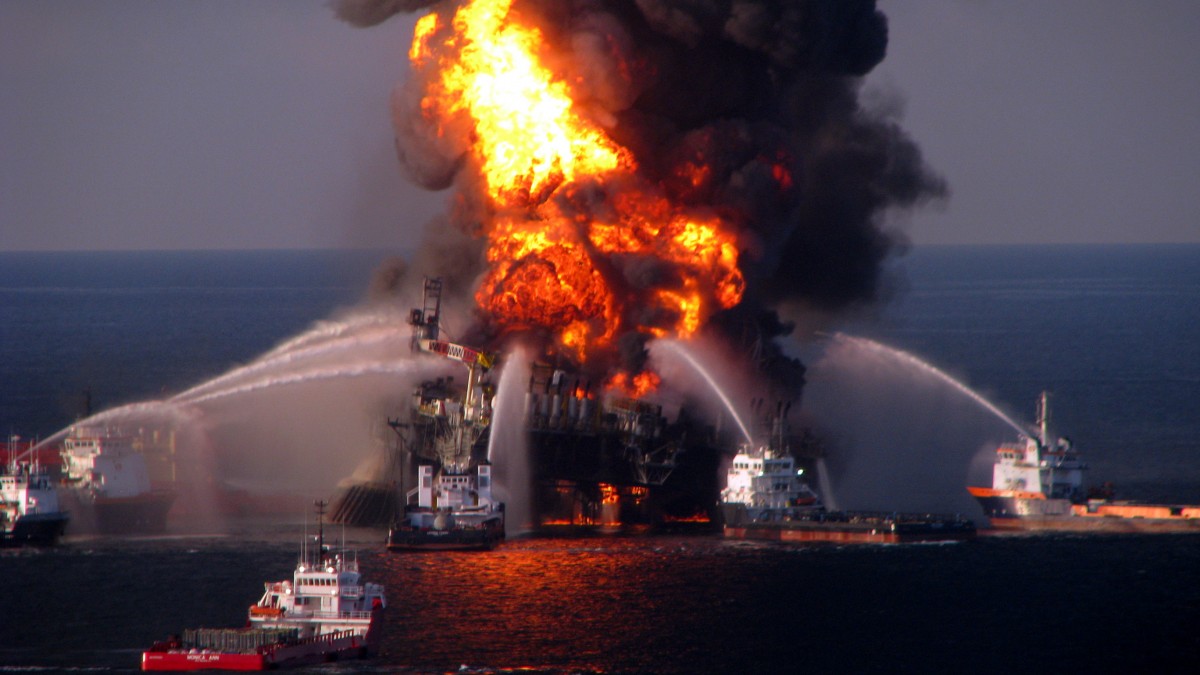
Fire response crews spray water on the burning remnants of BP’s Deepwater Horizon offshore oil rig. US Coast Guard | AP
As we are using ever increasing quantities of energy and resources just to extract more energy and resources, the surplus we have left to sustain the financing of the public goods and services necessary to maintain a functioning civilisation is declining. This doesn’t mean we are running out of energy — but it means that as the energetic and environmental costs of energy extraction increase, we effectively have less and less spare to invest back into key social goods.
French economists Victor Court and Florian Fizaine showed in a recent global EROI study that we are well passed the maximum levels of efficiency. The amount of energy we can extract from fossil fuels compared to the energy used to extract it was once lucratively high — around 44:1 in the 1960s. Since then it has inexorably declined to just over 30 overall, accompanied by a long-term slow-down in the growth rate of the global economy, a decline in productivity, and an expansion of debt. At this rate of decline, by 2100 we are projected to extract the same value of EROI from fossil fuels as we were in the 1800s. While there might be more actual total energy being produced by end of century, the surplus energy available could be at nineteenth century levels if we continue on a business-as-usual path of fossil fuel-dependence.
This predicament is already driving social unrest, communal polarisation and the resurgence of populism in a situation where neither governments nor wider publics really understand why economies continue to experience chronic dysfunction, instability and tepid growth.
The report to the UN forecasted that this trajectory means that the current economic system, which depends on endless growth to survive, simply cannot be sustained. It therefore portends a future of increasing unrest without a change of course. We will inevitably shift toward a new, different type of economy — if we don’t, then we face a heightened risk of social tensions that could cascade into conflict; and at worse we may well face the danger of collapse.
War in the mirror of civilisation
The risk of collapse is inherently entwined with war — industrial civilisation’s growth trajectory has not only enabled the technologies of war, but is in turn enabled by them.
Earlier this year, the main scientific committee established to determine the accuracy and nature of the definition of the Anthropocene signed off on its initial proposal positing 1950 as the starting date for the new geological era.
The sign off is the first stage of a longer scientific process to properly investigate and test what is still, in raw scientific terms, a mere hypothesis. The scientists based their preliminary evaluations on the mid-twentieth century as a major tipping point into a new era of human interference with the Earth’s geology, characterised by industrial expansion, the proliferation of agricultural chemicals, and most significant of all, the invention and deployment of the atomic bomb. The latter’s radioactive debris became embedded in sediments and glacial ice, becoming part of the geologic record. All this demonstrates an unprecedented and unmistakeable human footprint across the planet whose impacts will be seen for decades, centuries and millennia to come.
War, then, is carved into the sinews of the Anthropocene. While the twentieth and twenty-first centuries can be seen as exemplifying the inherently ecocidal dynamic of the exponential growth of human civilisation, they have also exhibited another parallel feature: the systematic proliferation of war, mass violence, and multiple forms of genocide.
These parallel features — ecocide and genocide; the destruction of our environmental life-support systems, and our direct destruction of the lives of members of our own species — do not coincide haphazardly, but are symptoms of the system of human life itself, in its current form.
From 1945 onwards, human civilisation was caught between the clash of two pseudo-scientific industrial ideologies of endless growth: capitalism and communism — the former premised on extreme privatisation and individuation, the latter premised on extreme nationalisation and collectivisation.
Both paradigms saw the Earth as little more than an external repository of resources to be exploited ad infinitum for the endless consumption of a human species, now self-defined by its capacity for technologically-driven industry.
Both promised that their paradigms would herald utopian oases of industrial prosperity for their respective societies.
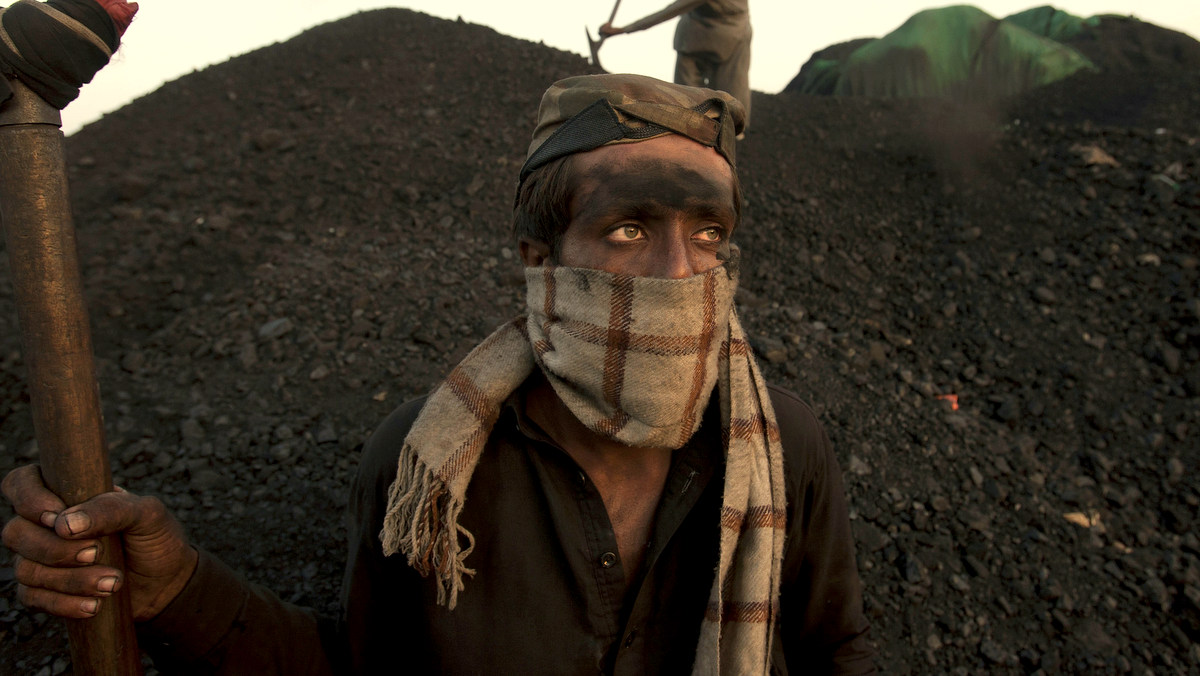
Waseem Akram takes a break while working at coal depot in Karachi, Pakistan. Shakil Adil | AP
In reality, both not only ‘Otherised’ the Earth itself as merely a resource to be consumed by human beings as a predator species, they simultaneously ‘Otherised’ large sections of working populations in and beyond their own demarcated territories, as little more than instruments by which to endlessly accelerate industrial productivity; and they both went on to mindlessly ‘Otherise’ each other whenever they clashed with each other (and even when they did not).
The result was that in their very different efforts to expand, both systems resulted in the mass deaths of millions of people on a colossal scale.
The Soviet Union and Maoist China deployed brutal collectivisation methods on their path toward accelerating productivity, which produced foreseeable mass deaths. This included the generation of devastating artificial famines. Stalin’s policies eliminated between 20 and 60 million people; Mao’s ‘Great Leap Forward’ caused 27 million people to starve to death.
But liberal Western governments also left a trail of blood of a quite distinct kind, in the first major spate of violence since the dawn of the Anthropocene as so far tentatively defined.
From 1945 onwards, Western governments under the leadership of the United States — bearing the mantle of leader of the ‘Capitalist Free World’ — pursued a continuous sequence of direct and covert military interventions across the world. Western military interventions generated a continuum of violence in over 70 developing nations across Asia, Africa, South America and the Middle East from mid-century until today.
British historian Mark Curtis calculates that the total number of direct and indirect deaths from these interventions is approximately 8.6–13.5 million — a conservative underestimate, he qualifies. The interventions were often aimed at quelling nationalist movements for self-determination. Although publicly justified as defensive actions to repel communist subversion, Curtis’ evaluation of historical archives from the US and British governments revealed that policy planners had deliberately inflated the communist threat to justify a militarism aimed at defending Western business interests and acquiring control of critical resources and raw materials. In the Middle East, the biggest prize was control of strategic fossil fuel reserves, the very lifeblood of economic growth.

Members of 1st Brigade, 3rd Infantry Division sit in a C-17 at Sather Air Base in Baghdad, Iraq. Maya Alleruzzo | AP
Development economist J. W. Smith has offered a higher estimate of the death toll, which he puts somewhere between 12–15 million deaths directly due to Western military interventions, with further “hundreds of millions” dying as an indirect consequence of the destruction and reconfiguration of their economies. Smith traced how Western interventions paved the way for the imposition of new capitalist social relations designed to extinguish domestic resistance and forcibly integrate developing countries into the global capitalist economy.
In the twenty-first century, this war trajectory has escalated, not waned. The driving motor remains the use of force to expand access to resources and labour, in order to lubricate the ever-expanding networks of global capital. It is a process sanitised, though, by various ideologies of humanitarianism, benign developmentalism, and ‘national security’.
The principal interventions of the ‘war on terror’ in Iraq and Afghanistan, for instance, are resource wars in core ways.
British Foreign Office documents prove clearly that American and British policy-planners saw the invasion and occupation of Iraq as a way to consolidate access to one of the world’s largest oil reserves, while ensuring the continued flow of to global markets with a view to help stabilise the global economy. In Afghanistan, Congressional records have revealed longstanding US-Western efforts to establish a trans-Afghan pipeline route for the transport of oil and gas from Central Asia to Western markets, bypassing US rivals Iran and Russia. In the 1990s, the US and British even funnelled support to the Taliban in a failed bid to establish the ‘security’ needed to pursue the plan.
Consecutively, the Obama and Trump administrations both continued to back the pipeline project which remains under construction.
In the Anthropocene, resource wars are bipartisan.
Both conflicts wrought colossal violence. Although the more widely accepted estimates of deaths in the hundreds of thousands are terrible enough, higher scale estimates could be more accurate, ranging up to a total of around 4 million people killed directly and indirectly across both conflicts since 1990.
Since then, war in the Anthropocene has intensified and proliferated in new and surprising ways as the more vulnerable nodes of human civilisation have begun to experience overlapping levels of failure and collapse due to the slow acceleration of converging climate, energy, food and water crises. The 2011 Arab Spring uprisings spiralled into a protracted, coalescing amalgamation of riots, civil wars and armed conflicts encompassing multiple theatres, Syria, Yemen, Libya and beyond.
The Arab Spring had been triggered by food price shocks which were, in turn, driven by a confluence of economic-energy shocks interacting with a series of climate shocks which had led to droughts and extreme weather crises across the world’s major food basket regions. Many Arab Spring countries from Syria to Egypt to Yemen had slashed subsidies for food and fuel in preceding years, largely due to the collapse of state revenues — many of them had been former major oil exporters, but in the mid-1990s had experienced peaks of their domestic conventional oil resources. As production thus declined, so did export revenues. With subsidies in the years before 2011 disappearing, coupled with global price spikes due to rampant market speculation on commodity prices coupled with global food shortages, prices of staple foods in these largely import-dependent countries rocketed. As the price of bread became unaffordable, people across the region hit the streets.
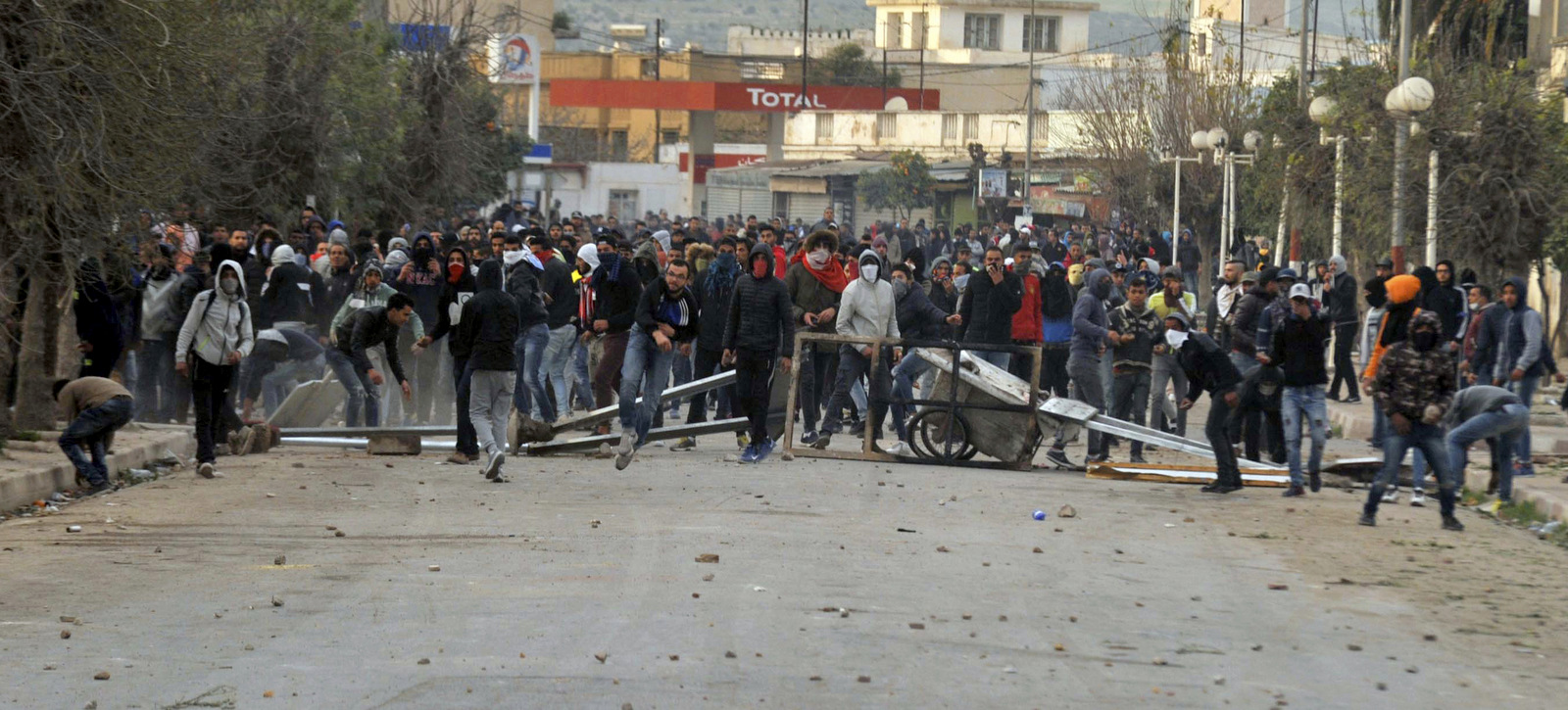
Protesters take the streets during anti-government protests, in Tebourba, south of the Tunisian capital, Tunis, Jan. 9, 2018. Anis Ben Ali | AP
The Earth system crisis of the Anthropocene played a critical role in prolonging and amplifying this Middle East crisis, which in turn drove migration and asylum seeking from 2011 to 2015 to an unprecedented degree. Some 11.5 percent of the population of Syria alone has been killed in the ensuing conflict. The West, Russia, Iran, Turkey, Saudi Arabia, Qatar and the UAE have vied for control of Syria for a range of geopolitical reasons, not least of which was its centrality to potential transhipment routes for oil and gas to global markets. Partisans of these different forces tend to absolve their favoured side(s) of complicity, but it is worth noting that prior to the 2011 uprising the State Department was actively negotiating with Syria and EU officials to push forward a pipeline route through the country to transport Iraqi oil to Europe; Russia simultaneously saw Assad’s efforts to capitalise on Syria’s strategic position vis-a-vis the region’s energy corridors as a fundamental threat to Putin’s own gas export plans — the war provided the ideal spoiler, with each side using it to try to further their own interests, the Syrian people be damned.
In the Anthropocene, so-called anti-imperialists have few qualms about fighting resource wars in their own self-interest.
The million plus migrants that turned up on the shores of Europe did so as a direct result of these wars. They were escaping devastating geopolitical conflicts amplified by vested interests, but which had also been created or exacerbated by severe droughts amplified by climate change.
According to the co-author of a key study of the climate-migration connection, Dr Raya Muttarak — a senior lecturer in geography and international development at the University of East Anglia: “The effect of climate on conflict occurrence is particularly relevant for countries in Western Asia in the period 2010–2012, when many were undergoing political transformation during the so-called Arab Spring uprisings.” Muttarak and his team showed that climate change laid the groundwork for the simmering tensions which led to the outbreak of war in Syria and across parts of the region, by generating droughts that led to mass migration.
The mass migration triggered by these processes, in turn, have transformed and radicalised politics across the Western hemisphere. They provided the fodder for extreme nationalist narratives funded by colossal quantities of ‘dark money’ from a cross-section of trans-Atlantic right-wing elites, many of whom hold vested interests in perpetuating deregulation for fossil fuel giants and other giant corporations.
The mass migration thus stoked nativist fears that helped fuel the rise of extreme nationalist movements, which suddenly found renewed constituencies for their views and policies with increasing numbers of ordinary citizens who felt disillusioned with the prevailing order, but had no way of making sense of it. They knew, can feel, that something is deeply wrong, that the old order is collapsing, but their diagnosis is incomplete, narcissistic, fragmented and symptom-oriented. As such, it has led to incomplete, narcissistic, fragmented and symptom-oriented political reactionism.

Protesters block full of immigrant children during a protest outside a U.S. Border Patrol Processing Center in McAllen, Texas. David J. Phillip | AP
The series of victories for the far-right that followed the eruption of Earth system crisis in the Middle East between 2011 and 2015 can thus be seen as a direct consequence of an incoherent cognitive response to the crisis, which reacted purely to its chief symptom: the desperate mass movement of vulnerable peoples.
We thus witnessed a series of seismic shifts in the reconfiguration of Western political systems, a hardening and centralising of power, a self-centring of values, a defensive rejectionism of science, and a polarising of identities, manifesting in a string of extreme nationalist wins. In 2014, far-right parties won just under a quarter of all seats in the European Parliament. In 2015, David Cameron was re-elected as Prime Minister with a parliamentary majority, a victory attributed in part to his promise to hold a referendum on Britain’s membership of the European Union. Unbeknownst to many, the Tories had quietly established wide-ranging links with many of the same far-right parties that were now capturing seats in the EU. The following year in June, the ‘Brexit’ referendum shocked the world with its result: a majority vote to leave the EU. Six months later, billionaire real estate guru Donald Trump became president of the world’s most powerful country. Like the Conservatives in the UK, the Republicans too had forged trans-Atlantic connections with European parties and movements of the extreme-right. Since then, far-right parties have made continued electoral gains across Europe in Italy, Sweden, Germany, France, Poland and Hungary; they are now just short of a third of seats in the European Parliament — and they are rapidly consolidating elsewhere, in the Philippines, Brazil, India, Myanmar and beyond.
The troubles and tribulations of contemporary politics, the increasing polarisation between left and right, the chronic incapacity to engage constructively across ideological divides, have become a pantomime hyperreality obsessing our consciousness through our television screens, desk computers, laptops, smartphones and wearable devices. The missing link is the planetary context — the crises of contemporary politics are, indeed, tidal waves, but they are occurring on the surface of an ocean in turmoil, of which, for all intents and purposes, we remain oblivious.
Political crisis is a symptom of the accelerating Earth system crisis. And as Clausewitz famously said, war is a continuation of politics by other means.
Colonisation and globalisation in the Anthropocene
Not everyone agrees, though, that the Anthropocene began in the mid-twentieth century. Some argue that there is a strong geological case for the Anthropocene commencing with the dawn of modern global empire.
British geographers Simon Lewis and Mark Maslin have put forward a much earlier date for this unprecedented era, one that “adheres to the geological criteria for defining an epoch: 1610. This date marks the irreversible exchange of species following the collision of the Old and New worlds”, which coincided with “an associated unusual drop in atmospheric CO2 captured in Antarctic ice cores.”
This alternative dating for the Anthropocene derives from the measurable impact of farming in relation to the colonisation of America by the Spanish, a pivotal event which many historians see as marking the inception of a new, distinctive age of empire that facilitated the birth of global capitalism. The drop in CO2 at the time, visible today in the ice cores, resulted from “vegetation regrowth on abandoned farmlands following the deaths of 50 million indigenous Americans (mostly from smallpox brought by Europeans). The annexing of the Americas by Europe was also an essential precursor to the Industrial Revolution and therefore captures associated later waves of environmental change.”
This alternative dating offers a compelling re-envisioning of the Anthropocene that associates it directly with the violence of empire, with the 1610 date providing the bridge connecting the historical violence of colonial discovery with its ensuing expansionism through biological conquest.
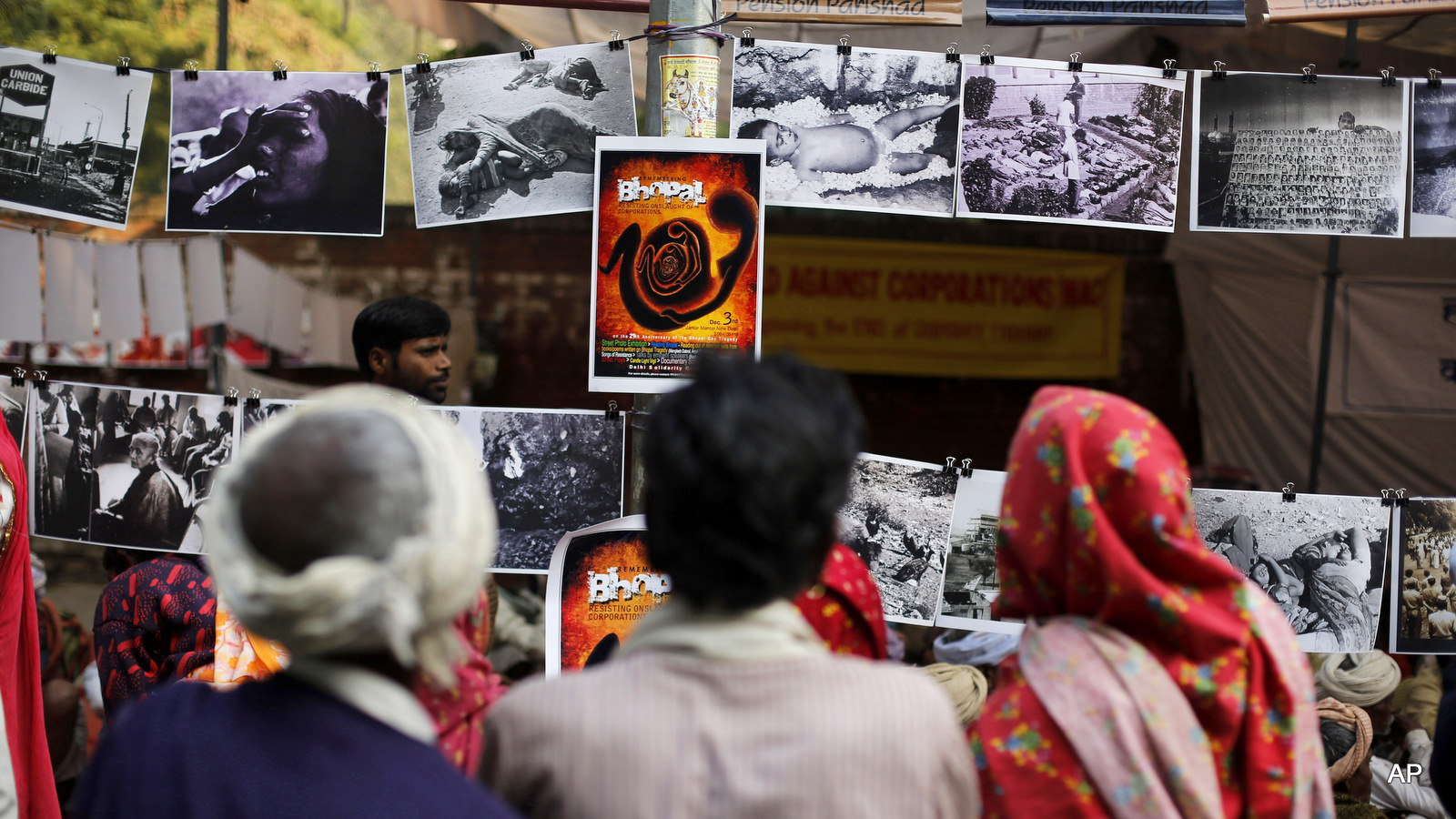
Survivors and supporters look at photos of vitctims of the Bhopal gas disaster in New Delhi, India. Photo | AP
This encompassed the mass ‘free market’ famines in Ireland and India, which saw the deaths of one million and up to 12 million respectively; as well as the trans-Atlantic slave-trade which saw the deaths of as many as 65 million Africans over five centuries — a blood-drenched international regime that was inextricably linked to the formation of a capitalist world system that helped facilitate Britain’s industrial revolution.
By this standard, the Anthropocene — encompassing the period in which the human species most profoundly and near-permanently began transforming the very geology of the Earth — simultaneously represents the rapid expansion of empire, and with it, the systematic construction of new racial categories to legitimise the emerging system of global apartheid that came with it.
In this very period, we saw the dawn of scientific racism, the formal and scientifically-justified concept of multiple races, the grotesque legacy of which we continue to struggle with today. The idea that there are different ‘races’ can be traced back to the political appropriation and distortion of neo-Darwinian theories of evolution to underpin racial hierarchies which positioned white Europeans at the pinnacle of civilised human advancement in this juggernaut of global industrial expansion.
Racism, then, is not discrimination against other ‘races’. It is the very act of creating the notion of a distinctive ‘race’ of people — that is, of possessing common generalised characteristics, an act inseparable from the very dawn of the Anthropocene, which witnessed the emergence of a civilisation defined by its insatiable hunger for resources and labour.
Polarised constructions of the ‘Other’ have played a crucial ideological function throughout the Anthropocene, cleaving human beings from the environments in which they find themselves, and cleaving them apart from each other into exploitative factions of power. And so it is no surprise that the formalisation of racism as a global system appeared to solidify during the industrial revolution, as the human species’ domination of the Earth began to reach exponential acceleration.
In the early nineteenth century, racism manifested largely as a religious ideology linked to interpretations of the Bible, viewing non-European groups as inherently inferior due to their heathen beliefs and ancestry, and frequently targeted Jews. From the mid-nineteenth to the early twentieth centuries, racism evolved on the basis of scientifically-justified biological theories which attributed fixed traits, behaviours, characteristics, abilities and disabilities to constructed groups of people based on their supposedly distinctive biological characteristics. Since then, racism has continued to evolve and is largely underpinned by a cultural theory which still projects homogenised constructions of different social groups with common traits and characteristics, but derived instead from their affiliation to a culture, ethnicity, nation, language or faith. Often, racism today borrows from across these subliminal theories — its proponents frequently not even recognising what they are doing.

Israeli police watch as women wait to cross the Qalandia checkpoint between Ramallah and Jerusalem, a checkpoint only Palestinians are required to use. Majdi Mohammed | AP
The late sociologist Stuart Hall famously described “race” as a “floating signifier”. Rather than being a fixed concept, he explained, race has always been a deeply and inherently political construct, projected by powerful dominant groups, justifying unequal power relations with other groups. As such, it is a construct that changes and adapts to historical circumstance. Far from being exclusively biologically determined, Hall showed that the new type of cultural racism moves beyond discrimination related to skin colour. Instead, it focuses on the imagined cultures of people, generalised abstractions about their beliefs and practices, projecting a hierarchy of cultures. Racialised stereotypes can thus cut across colour divides, and ‘non-racial’ categories like faith, culture and civilisation can become racist code for similar discriminatory practices. One result is the projection of an unsurpassable divide between the “West” and “the Rest”, in which “Westerners” are seen as “civilised”, “safe”, “known”, while “migrants”, “Muslims”, “asylum seekers”, “foreigners” and so on are viewed as “uncivilised”, “dangerous”, and “different”.
The deepening and acceleration of identity-politics is a defining feature of the tail-end of the Anthropocene, as the endless growth project of maximum extraction, exploitation and centralisation of resources invents and entrenches multiple divides between human beings on its path of self-legitimisation. And so, too, the devastating impacts of the Earth system crisis remain racialised, with the worst consequences disproportionately affecting the poorer, darker nations around the world.
War is, perhaps, the most visible surface-symptom of the Anthropocene’s defining feature.
In the Anthropocene, we all become Others.
It is not yet too late to begin to actively redefine the meaning of the Anthropocene.
For ultimately, the character of the Anthropocene so far is a reflection of the system of human civilisation within the prevailing paradigm. This is a life-destroying paradigm, a death-machine whose internal logic culminates in its own termination. It is a matrix of interlocking beliefs, values, behaviours and organisational forms which functions as a barrier, not an entry-point, to life, nature and reality.
And in that sense, the end of this paradigm is utterly inevitable. But this does not erase the choice before us — which is to decide whether humanity will perish in the ashes of this paradigm, or plant seeds of a new life-affirming paradigm by building out an emerging system for the flourishing of a new ecological civilisation.
If human civilisation is to survive, it will not be what we see before us — erected on the blood of millions; premised on the exhaustion of planetary resources; crushing the bones of the poor, vulnerable and weak; hell-bent on self-annihilation — that does so. This is a paradigm beguiled by a techno-hyperreality of its own projection; a utopian simulacrum of endless growth, desperately attempting to conceal its own dystopic core from self-awareness.
And so our task is to reflect on what we have truly done to each other, and to the planet; and to recognise that these two phenomena are part of the same self-defeating paradigm: one which perpetually constructs a hyperreality of divisions, borders, and boundaries around projected externalisations of the ‘Other’, seemingly necessitating exploitative, parasitical behaviours. What emerges from this recognition is the relinquishing of the binary delusions that have riven the path of civilisation for hundreds of years, and thereby an embracing of a new vision of what it means to be human — retrieving the essence of our existence as beings who, together, have come from, and will inevitably return to, the Earth itself.
The End of Human Civlisation: War, Empire and Racism in the Anthropocene
 TheAltWorld
TheAltWorld 
0 thoughts on “The End of Human Civlisation: War, Empire and Racism in the Anthropocene”